Anxiety Statistics & Facts: How Many People Have Anxiety?

Report Highlights:
- 27.3% of American adults have anxiety problems [3].
- Anxiety disorders affect 3.94% of the worldwide population [14].
- 41.7% of young adults (18 to 29 years) suffer from anxiety [3].
- 9.4% of children in the US have anxiety [12].
- 36% of teens experienced higher anxiety levels during the pandemic [22].
- 31% of college students have an anxiety diagnosis [20].
- The prevalence of anxiety disorders in the US is higher in women at 30.8% than in men at 23.5% [3].
- 7.1% of the US population has social anxiety disorder [6].
- 94% of the workers feel stressed out at work [18].
- The COVID-19 pandemic caused a 25% increase in anxiety prevalence [9].
- 60.76% of healthcare workers felt higher fear and anxiety levels due to COVID-19 virus exposure [27].
- Only 36.9% seek treatment for anxiety disorders [6].
Anxiety disorder is one of the most common mental health disorders. Unlike normal anxiety, the symptoms of anxiety disorders don’t go away easily. They even grow worse as time passes that small triggers can easily prompt an anxiety attack.
Similar to other mental health disorders, people suffering from anxiety disorder need treatment. These include medications and behavioral therapy to help manage their symptoms.
Many factors can put you at a higher risk of developing an anxiety disorder [5].
- Family history of anxiety disorders
- Traumatic events, some of which can result in post-traumatic stress disorder
- Health problems like thyroid disorders
- Environmental factors like illicit drug use
Read on to discover the current anxiety statistics in the US, especially during the pandemic.
Anxiety Statistics — How Many People Have Anxiety?
27.3% of Americans aged 18 and over have symptoms of an anxiety disorder. The data comes from the 2022 Centers for Disease Control and Prevention [3].
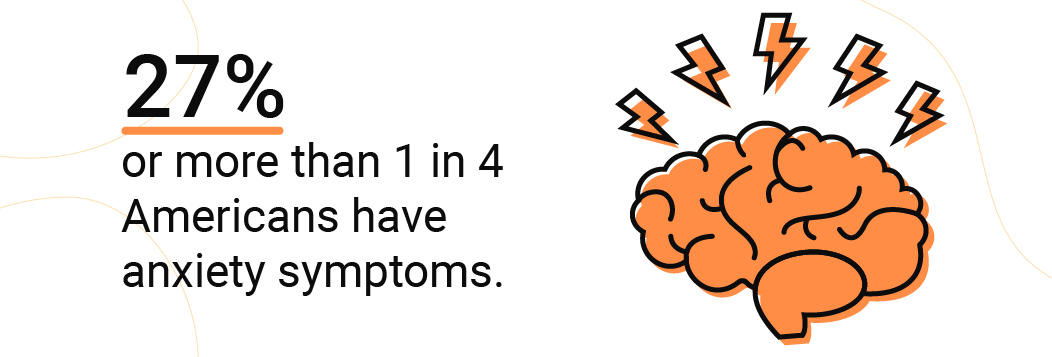
3.94% of the global population has symptoms of anxiety disorder [14].
How Many People Have Anxiety in the United States?
27.3% or more than a quarter of the US adult population aged 18 and over have anxiety disorder symptoms. This percentage increased from the 2019 National Health Interview Survey of 8.1% [3].
The state that had the highest anxiety indicators is Louisiana at 35.2%. Hawaii with 20.7% is the state with the lowest anxiety indicators [3]. The anxiety indicators are based on the reported frequency of symptoms.
How Many People Have Anxiety in the World?
Anxiety affects 3.94% of the global population or 301.39 million individuals in 2019. The worldwide prevalence of mental health problems like anxiety disorder has increased from 2017’s 293.55 million [26].

187.54 million women have anxiety in 2019, up from 2017’s 182.73 million. The number of men with anxiety also increased from 110.82 million in 2017 to 113.85 million adults in 2019 [25].
What Causes the Most Anxiety in the World?
35% of the respondents in a survey say that the COVID-19 pandemic is the top worrying concern in January 2022. This data comes from Ipsos’ survey “What Worries the World 2022” [36].
Poverty and social inequality land second place at 31%, followed by unemployment at 28% [36].
The least worrying concern is climate change. 15% of the respondents cited this as a major concern in 2022 [36].
Which Country Has the Highest Stress and Anxiety Levels?
74% of Afghanistan and Lebanon’s population report high stress and anxiety levels. This data is from the 2021 Gallup report on the most stressed countries [35].
The United States comes in ninth place. More than half of its population (52%) report high levels of stress and anxiety [35].
Kazakhstan and Uzbekistan, on the other hand, are the least stressed countries. Only 12% of both their populations experience high stress and anxiety levels [35].
How Common is Anxiety?
27.3% of Americans over 18 years have anxiety, says the CDC [3].
This means that more than a quarter of the adult population in the US suffers from anxiety symptoms [3].
Anxiety Prevalence Among Adults
41.7% or more than 2 in 5 young adults (18 to 29 years) suffer from this mental health problem. Of the different age groups, it affects those above the 80 years age group the least at 16% [3].
Its prevalence is higher in women at 30.8% than in men at 23.5%. It also affects bisexual people more, at 56.7%, than straight people at 24.8% [3].
Anxiety affects 37.2% of those who identify with multiple races. The second most affected group is the Hispanics and Latinos. 29.2% of their population deal with anxiety. Non-Hispanic Asian people deal with anxiety the least at 19.0% [3].
Anxiety affects people with disability more at 55.7%. It affects those without disabilities the least at 22.8% [3].
Anxiety Prevalence Among Children
9.4% or about 5.8 million children deal with anxiety symptoms, says the CDC [12].
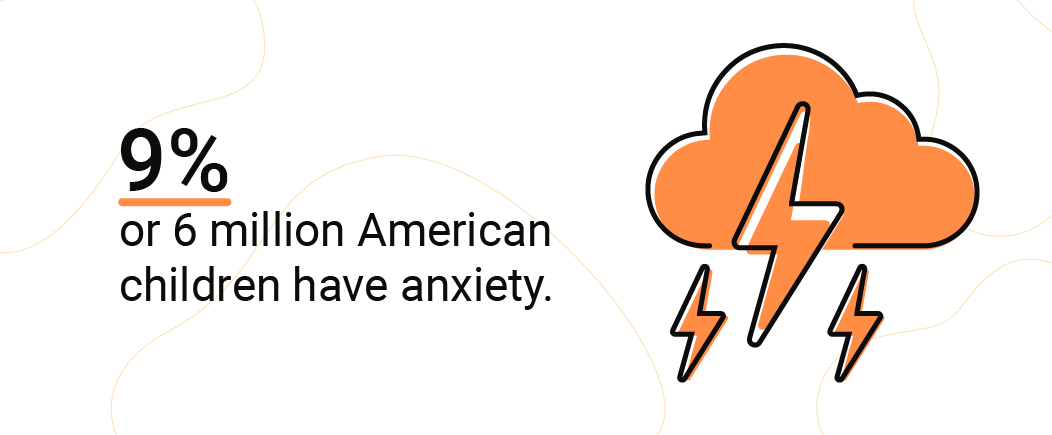
The prevalence of anxiety in children increased from 5.5% in 2007 to 6.4% in 2011 to 2012 [12].
Anxiety is most commonly seen in children between the ages of 12 and 17 years at 10.5%. It affects the youngest children the least at 1.3% [16].
Anxiety in children can also come with other mental health issues and vice versa.
32.3% or 1 in 3 children with anxiety have a depressive disorder. 37.9% or 1 in 3 children with anxiety also have behavioral problems [12].
Of these percentages, 59.3% or 6 in 10 children receive treatment for anxiety [12].
Anxiety Among High School Students
Anxiety and depression among teenagers are increasing, 7 in 10 teenagers see these mental health issues as major issues.
70% of high school students consider anxiety and depression as major problems, says a 2018 Pew survey [21].
26% of them think they’re just minor problems, while 4% say they’re not a problem at all [21].
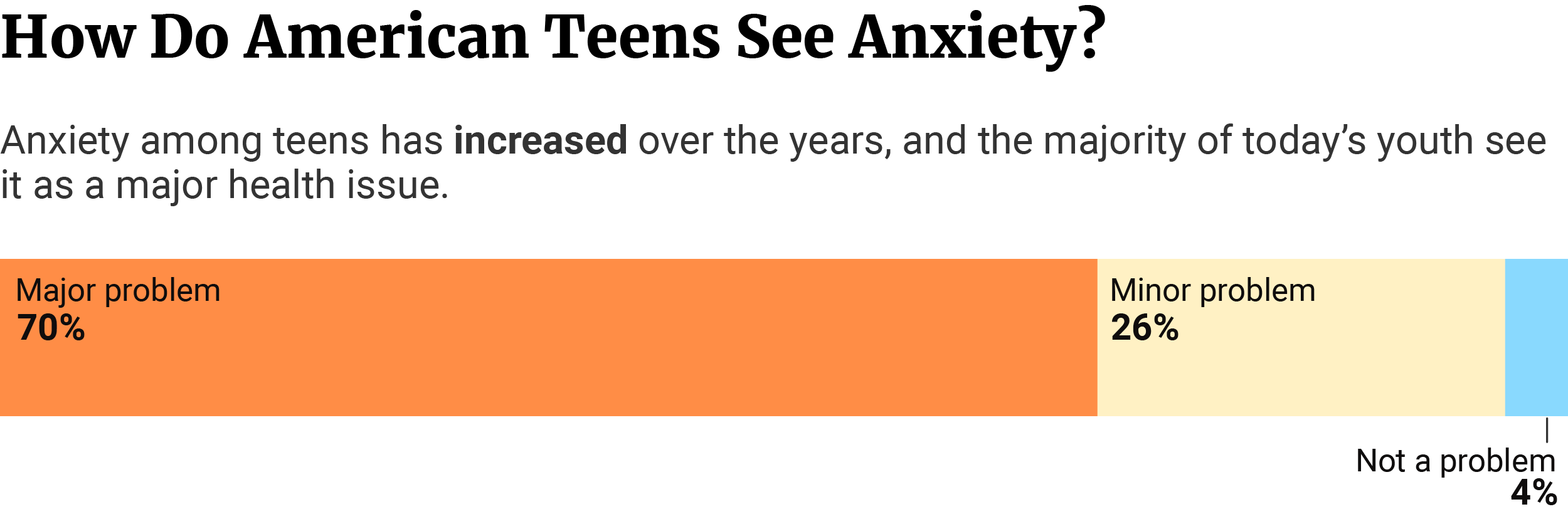
61% of the students say the primary pressure they face is academics and getting good grades. Pressure to look good and fit in with peers come in second and third places at 29% and 28% [21]. Pressure to look good and fit in with peers comes in second and third places at 29% and 28% [21].
Anxiety Among College Students
31% of college students have a lifetime diagnosis of an anxiety disorder. Their diagnoses were made by a healthcare professional. The data comes from a 2021 Healthy Minds Network survey [20].
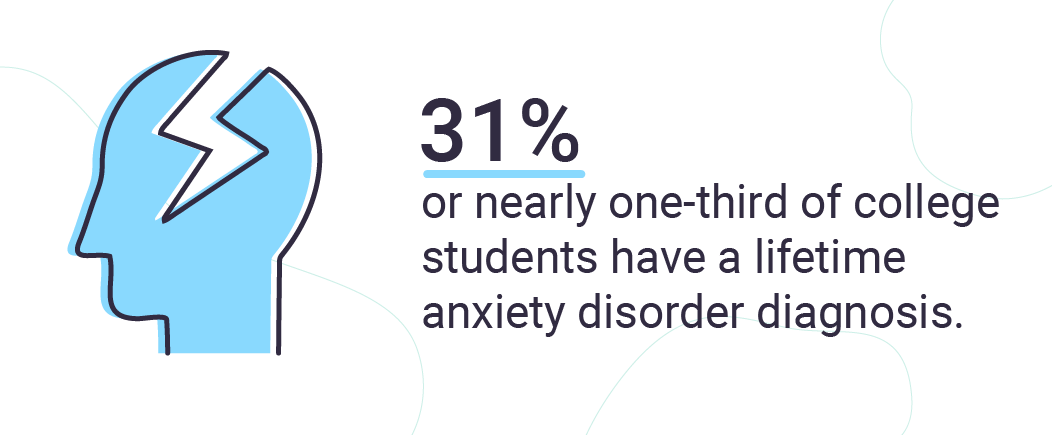
34% of the respondents tested positive for generalized anxiety disorder [20].
- 18% of them have moderate anxiety.
- 16% have severe anxiety.
12% of those with positive anxiety screens took anti-anxiety medications. These include medications like lorazepam and alprazolam [20].
40% (the past year) and 59% (lifetime) of those with positive anxiety screens received mental health counseling and therapy [20].
Anxiety Statistics by Educational Level
31.4% of people with some college and associate’s degree deal with anxiety the most. Anxiety affects those with a college education the least at 23.2% [3].
One reason for the disparity may be that people with higher educational levels are more likely to seek help. They're also more likely to get treated than people with a lower educational level.
The educational level also plays a role in how likely a person is going to seek treatment for mental health problems, including anxiety.
For each additional educational level, a person is more likely to see mental health services like [31]:
- Psychiatrists by 15%
- Family doctors by 12%
- Psychologists by 16%
- Social workers by 16%
Anxiety and Workplace Mental Health Statistics
95% of American workers admitted to feeling stressed out at work. Only 5% reported no stress [18].

The majority of American workers (39%) report moderate stress. 6% of them report unsustainably high stress [18].
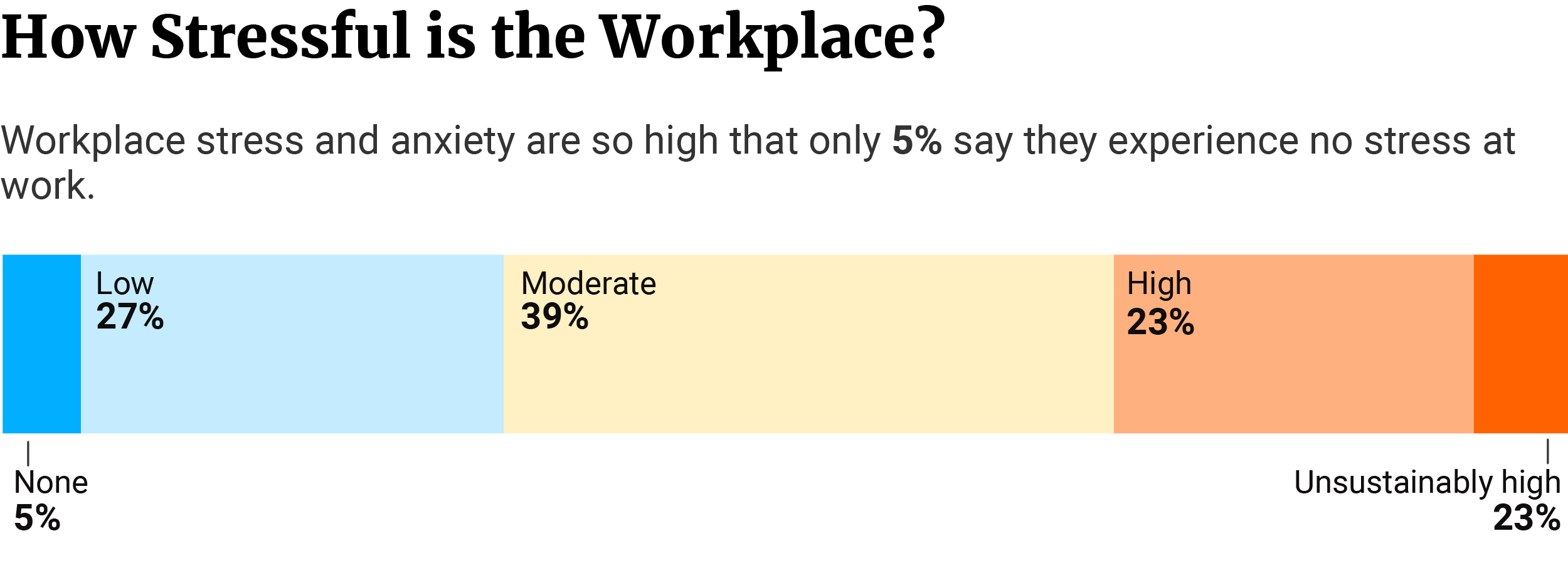
76% said that work-related stress negatively affected their personal lives and relationships [37].
66% say stress caused them to lose sleep, while 16% had to quit their job [37].
Issues affecting the country (including the pandemic) also affected workplace engagement. Fluctuations occurred the most during the summer months as tension rise. By July and September 2020, engagement levels went back to their pre-pandemic levels.
51% or more than half of American workers are not engaged with their company. They’re psychologically unattached not only to their company but to their work as well.
Only 36% of the workers are highly engaged, committed, and enthusiastic in the workplace [19].

The most stressed industry in 2021 is the arts, entertainment, and recreation industry at 63.4%. The healthcare industry follows in second place at 60.7% [13].
The COVID-19 pandemic affected both industries the most. The former received less government support. They also had very high restrictions. The healthcare industry, on the other hand, directly deals with the COVID-19 pandemic.
Anxiety Statistics During the COVID-19 Pandemic
The COVID-19 pandemic caused a 25% increase in the number of people with anxiety. The World Health Organization released the report last March 2022 [9].

Factors That Increased Anxiety During the COVID-19 Pandemic
According to the World Health Organization, factors that contributed to the rapid rise of anxiety during the pandemic include [9]:
- Social isolation and loneliness can worsen mental disorders
- Limitations and restrictions in one’s ability to work
- Limitations in seeking help and support for mental disorders
- Fear of infection for oneself and a loved one
- Suffering or death of a loved one
- Financial worries
Anxiety Among the General US Population
From 8.1% in 2019 to 25.5% in 2020, the prevalence of anxiety symptoms in the US increased three-fold. This data came from the 2020 MMWR report conducted by the CDC from April to June 2020 and compared to 2019’s data [11].
It affected women more, with 26.3% of their population dealing with higher anxiety levels. Of the male population, anxiety prevalence was 24.7% [11].
The age group that this mental illness affected the most was the younger adults. 49.1% or about half of the young adult population between 18 and 24 reported anxiety symptoms [11].
The least affected age group, on the other hand, was those above and equal to 65 years old. 6.2% of them reported anxiety symptoms [11].
Anxiety affected Hispanic people more at 35.5% than Asian, non-Hispanic individuals at 14.1% [11].
The most affected region in the US was the Southern region. 27.9% of the population reported anxiety symptoms. The least affected region was the Midwestern region at 22.7% [11].
Education, income, and type of work also affected people’s anxiety levels differently.
44.5% of people who have less than a high school diploma were more affected by anxiety. Those with a professional degree were affected the least at 20.9% [11].
30.6% of those earning less than $25,000 experienced more anxiety than 17.4% of those earning more than $200,000 [11].
35.5% of essential workers suffered from anxiety-related problems. Of those retired, only 9.6% of their population reported anxiety symptoms [11].
Anxiety Among Teens During the COVID-19 Pandemic
46% of teens (13 to 18 years old) developed new or worsened mental health conditions during the pandemic [22].
36% or more than 1 in 3 teen girls showed anxiety symptoms during the COVID-19 pandemic. In boys, 19% or nearly 1 in 5 teen boys showed symptoms of anxiety. This data comes from the 2021 Mott Poll Report [22].
3 in 4 parents say the pandemic significantly affected their teens’ mental health [22].
Anxiety Among Healthcare Workers During the COVID-19 Pandemic
37.73% of them reported anxiety symptoms. This data came from a survey conducted by the American Medical Association in 2020 [27].
Anxiety affected 39.3% of female and 26.4% of male healthcare workers [27].
60.76% of healthcare respondents felt high fear levels of COVID-19 exposure [27].
Anxiety and the War in Ukraine Statistics
87% of American adults say inflation and rise in commodity prices related to the war in Ukraine cause the most stress and anxiety in 2022 [32].
87% of adults also feel that the past two years have been nothing but a series of world crises. 69% think we’re on the brink of World War III. 69% also think the war between Ukraine and Russia can result in a nuclear war [32].
Anxiety about money increased from 57% in 2021 to 65% in 2022. Anxiety about the economy also increased from 58% in 2021 to 65% in 2022 [32].
Anxiety Disorders and Comorbid Mental Health Disorders
According to the Substance Abuse and Mental Health Services Administration, common anxiety disorders can come hand-in-hand with substance use disorders [24].
20% of people with mental health disorders like anxiety and mood problems have substance use disorders. Similarly, 20% of people with substance use disorders have mental health disorders [33].
Panic disorder is also very common in people with post-traumatic stress disorder [7].
- Diagnosis of post-traumatic stress disorder gives you a 60% higher risk of developing it.
- 69% of people seeking post-traumatic stress disorder treatment have panic attacks.
Other mental health disorders associated with anxiety disorders include depression and eating disorders.
- 50% of those suffering from depression also have anxiety disorder [6].
- 56% of people dealing with eating disorders also suffer from anxiety [4].
Social Anxiety Disorder Statistics
7.1% of the American population has a social anxiety disorder (SAD). The condition affects 15 million adults [6].
It’s more common in women, with 5.67% of their population suffering from a social anxiety disorder. In men, SAD affects 4.2% of the population [1].
The median age of onset of social anxiety symptoms among youths is 13 years old [15].
SAD is also closely related to other mood problems. 70% to 80% of people with SAD have co-existing mental health issues. These include anxiety disorders and substance use disorders [34].
Less than 5% of people with this type of mental health disorder seek treatment for their condition [30].
More than a third of the people seek help only after 10 years or more of dealing with the symptoms [30].
Anxiety Relief Statistics
Only 36.9% seek help from a healthcare provider and receive treatment [6].
Mental health disorders like anxiety disorder are highly treatable. Anxiety treatment can include anxiolytic drugs as well as complementary and alternative medications. Some people also include CBD and cannabis in their anxiety treatment regimen.
Anti-Anxiety Drugs
The most commonly prescribed anti-anxiety medications for common anxiety disorders include:
- Selective serotonin reuptake inhibitors or SSRIs (Prozac, Celexa, or Zoloft)
- Serotonin-norepinephrine reuptake inhibitors or SNRIs (Effexor, Pristiq, or Cymbalta)
- Benzodiazepines (Valium, Ativan, or Xanax)
- Tricyclic antidepressants (Pamelor, Norpramin, or Tofranil)
There had been an increase in the use of anti-anxiety medications as the pandemic began to spread in the US.
Prescriptions for anti-anxiety drugs increased by 34.1%, up from about 2.3%. The use of anti-anxiety medications also increased by 18% by March 15, 2020 [2].
Using anti-anxiety medications was higher in women at 39.6%, compared to men at 22.7% [2].
Of those taking anxiolytics, 50% also take antidepressant drugs for major depressive disorder. 16.1% take anti-insomnia medications [2].
Complementary and Alternative Medications or CAM
Other anxiety treatments include complementary and alternative medicine. These teach people how to manage their anxiety symptoms.
29.2% of people practice meditation to relieve anxiety and 21% use it to relieve stress, says a study [10].
Exercise and an active lifestyle can lower the risk factors for anxiety disorder by 60% [17].
73% found improvement with lifestyle changes. These include eating healthier foods, getting more restful sleep, or exercising [29].
Relaxation techniques and acupuncture may also help. These reduce mental health issues like anxiety and major depressive symptoms [28] [38].
CBD for Anxiety
50% of survey respondents say they use CBD to relieve anxiety and stress, while 45% use it to improve sleep [23].
55% or more than half of the respondents say they use CBD to relax [23].
10% of men use CBD regularly, compared to 4% of women [23].
12% of those who are 35 to 44 years use CBD the most, compared to 2% of those who are 65 years and above [23].
Cannabis for Anxiety
65.49% of a survey’s respondents say weed alone is okay for anxiety relief during the COVID-19 pandemic [8].
34.51% of them used cannabis with other anti-anxiety supplements [8]. Of this percentage,
- 76% felt cannabis for anxiety is more effective for this mental health disorder.
- 24% felt cannabis for anxiety isn’t that effective at relieving the symptoms.

29.28% reported using more cannabis for anxiety and stress caused by the COVID-19 pandemic. 5.70% said they quit smoking cannabis. The data comes from a 2020 survey of 1,017 cannabis users [8].
Anxiety Support
Anxiety disorders affect 27.3% of Americans and 3.94% of the global population. It’s a highly treatable mental health issue, but only 36.9% of them seek treatment.
If you have a family history of anxiety disorder or a closely related family member is suffering from mental health disorders, please reach out and seek help from a healthcare professional. This is especially important if have additional symptoms like suicidal thoughts and behaviors.
Hotline numbers that you can call are SAMHSA’s National Helpline at 1-800-662-HELP (4357) or National Alliance on Mental Illness (NAMI) Helpline at 1-800-950-NAMI (6264).
References
- Ambusaidi, A., Al-Huseini, S., Alshaqsi, H., AlGhafri, M., Chan, M. F., Al-Sibani, N., Al-Adawi, S., & Qoronfleh, M. W. (2022). The Prevalence and Sociodemographic Correlates of Social Anxiety Disorder: A Focused National Survey. Chronic Stress, 6, 247054702210812. [1]
- America’s State of Mind U.S. trends in medication use for depression, anxiety, and insomnia. (2020). Express Scripts. [2]
- Anxiety and Depression. (2022). Centers for Disease Control and Prevention. [3]
- Anxiety, Depression, & Obsessive Compulsive Disorder. (2018). National Eating Disorders Association. [4]
- Anxiety disorders. (2018). Mayo Clinic. [5]
- Anxiety Disorders - Facts & Statistics. (2021). Anxiety and Depression Association of America. [6]
- Berenz, E. C., York, T. P., Bing-Canar, H., Amstadter, A. B., Mezuk, B., Gardner, C. O., & Roberson-Nay, R. (2018). Time course of panic disorder and posttraumatic stress disorder onsets. Social Psychiatry and Psychiatric Epidemiology, 54(5), 639–647. [7]
- Blake, D. K. (2020). COVID-19 Impacts on Weed-smoking Habits and Attitude towards It. AmericanMarijuana.org. [8]
- COVID-19 pandemic triggers 25% increase in prevalence of anxiety and depression worldwide. (2022). World Health Organization. [9]
- Cramer, H., Hall, H., Leach, M., Frawley, J., Zhang, Y., Leung, B., Adams, J., & Lauche, R. (2016). Prevalence, patterns, and predictors of meditation use among US adults: A nationally representative survey. Scientific Reports, 6, 36760. [10]
- Czeisler, M., Lane, R. I., Petrosky, E., Wiley, J. F., Christensen, A., Njai, R., Weaver, M. D., Robbins, R., Facer-Childs, E. R., Barger, L. K., Czeisler, C. A., Howard, M. E., & Rajaratnam, S. M. (2020). Mental Health, Substance Use, and Suicidal Ideation During the COVID-19 Pandemic — United States, June 24–30, 2020. MMWR. Morbidity and Mortality Weekly Report, 69(32), 1049–1057. [11]
- Data and Statistics on Children’s Mental Health. (2022). Centers for Disease Control and Prevention. [12]
- Dodge, M. (2021). The Most Stressful Jobs in 2021. Jobillico. [13]
- Elflein, J. (2022). Share of the population worldwide who suffered from anxiety disorders from 1990 to 2019. Statista. [14]
- Freidl, E. K., Stroeh, O. M., Elkins, R. M., Steinberg, E., Albano, A. M., & Rynn, M. (2017). Assessment and Treatment of Anxiety Among Children and Adolescents. Focus (American Psychiatric Publishing), 15(2), 144–156. [15]
- Ghandour, R. M., Sherman, L. J., Vladutiu, C. J., Ali, M. M., Lynch, S. E., Bitsko, R. H., & Blumberg, S. J. (2019). Prevalence and Treatment of Depression, Anxiety, and Conduct Problems in US Children. The Journal of Pediatrics, 206, 256–267.e3. [16]
- Gorey, C. (2021). Regular exercise may lower the risk of developing anxiety by almost 60%. Frontiers. [17]
- Hansen, B. (2021). Crash and Burnout: Is Workplace Stress the New Normal? Wrike, Inc. [18]
- Harter, J. (2020). U.S. Employee Engagement Reverts Back to Pre-COVID-19 Levels. Gallup, Inc. [19]
- The Healthy Minds Study 2021 Winter/Spring Data Report. (2021). Healthy Minds Network. [20]
- Horowitz, J. M., & Graf, N. (2019). Most U.S. Teens See Anxiety and Depression as a Major Problem Among Their Peers. Pew Research Center. [21]
- How the Pandemic Has Impacted Teen Mental Health. (2021). C.S. Mott Children’s Hospital, the University of Michigan, 38(2). [22]
- Kopf, D., & Avins, J. (2019). Survey shows Americans use CBD to treat anxiety and stress. Quartz. [23]
- Mental Health and Substance Use Co-Occurring Disorders. (2022). MentalHealth.gov. [24]
- Number of people with anxiety disorders, World, 2017 to 2019. (2021). Our World in Data. [25]
- Number with a mental or neurodevelopmental disorder by type, World, 2017 to 2019. (2021). Our World in Data. [26]
- Prasad, K., McLoughlin, C., Stillman, M., Poplau, S., Goelz, E., Taylor, S., Nankivil, N., Brown, R., Linzer, M., Cappelucci, K., Barbouche, M., & Sinsky, C. A. (2021). Prevalence and correlates of stress and burnout among U.S. healthcare workers during the COVID-19 pandemic: A national cross-sectional survey study. EClinicalMedicine, 35, 100879. [27]
- Relaxation Techniques: What You Need To Know. (2021). National Institutes of Health. [28]
- The role of science in mental health. (2021). Wellcome Global Monitor. [29]
- Social Anxiety Disorder. (2010). Anxiety and Depression Association of America. [30]
- Steele, L. S., Dewa, C. S., Lin, E., & Lee, K. L. (2007). Education level, income level, and mental health services use in Canada: associations and policy implications. Healthcare Policy = Politiques de Sante, 3(1), 96–106. [31]
- Stress in America: On the second COVID-19 anniversary, money, inflation, and war pile on to a nation stuck in survival mode. (2022). American Psychological Association. [32]
- Substance Use Disorders. (2021). Anxiety and Depression Association of America. [33]
- Thomas, L. (2017). Social Anxiety Epidemiology. News-Medical.net. [34]
- What Is the World’s Emotional Temperature? (2022). Gallup, Inc. [35]
- What Worries the World? (2022). Ipsos Global Advisor. [36]
- Workplace Stress Continues to Mount. (2018). Korn Ferry. [37]
- Yang, X. Y., Yang, N. B., Huang, F. F., Ren, S., & Li, Z. J. (2021). Effectiveness of acupuncture on anxiety disorder: a systematic review and meta-analysis of randomized controlled trials. Annals of General Psychiatry, 20(1). [38]